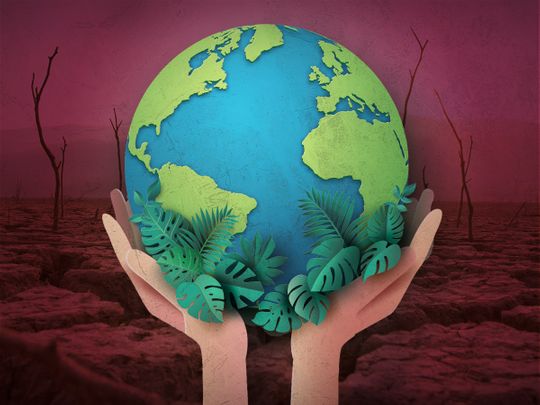
Since 1970, the world has been observing April 22 as Earth Day. A major oil spill in Santa Barbara, California, in 1969 led to a massive environmental disaster. On its first anniversary, Wisconsin Senator Gaylord Nelson spearheaded a popular movement to convince the US government that the planet was at risk and that environmental reforms were needed.
To force the environmental issue onto the national agenda, April 22 1970, was observed as Earth Day, and millions of Americans participated in rallies across the country. Though the idea of celebrating Earth Day started in the US, it became global by 1990, and billions of people worldwide observe it yearly. Earth Day probably has become the largest secular event in the world.
This year’s Earth Day theme is “Invest in our Planet,” particularly to highlight the effects of climate change and efforts to mitigate it. The pandemic, the war in Ukraine, and several proxy wars in different parts of the world have kept the focus away from the dangers of climate change. Just because climate change doesn’t dominate global security and political discourse, its challenges to the health and well-being of the planet and human civilisation have not disappeared.
A gloomy picture of droughts, floods and heatwaves
Climate change’s physical and socioeconomic impacts have become increasingly devastating without sustained, robust, and proactive actions. The annual report of the World Meteorological Organisation (WMO), “State of the Global Climate 2022,” released a day before the 2023 Earth Day, paints a very gloomy picture as droughts, floods, and heatwaves affecting societies worldwide, besides the loss of billions of dollars. The melting of ice and sea level rise are also compounding the problem. Despite over 190 countries celebrating Earth Day for over half a century, the planet’s health is alarming.
The accumulation of three leading greenhouse gases reached a record level in 2021, and its concentration continued to increase in 2022. Methane is the most dangerous greenhouse gas as it traps heat 25 times more than carbon dioxide, and from 2020 to 2021, its annual increase was the largest on record. The planet is also becoming warmer with the rise of greenhouse gas concentration. The WMO report indicates that the global mean temperature in 2022 was 1.15 degrees C above the 1850-1900 average, and the last eight years were eight warmest years since 1850.
Despite widespread anxiety and concerns about climate change and its threats, the political will is still missing to prioritise climate in policymaking and planning.
While the planet is becoming warmer, the rainfall pattern has become abnormal. In 2022, large parts of Asia, the southwest Pacific, the eastern Sahel, Sudan, and eastern Europe suffered from above-normal rainfall. Still, many countries in Western Europe, the Middle East, East Africa, Central Asia, South America, and North America got much less rain than usual.
Due to the drastic abnormality in rainfall, while the drought in East Africa became severe in 2022, Pakistan suffered terribly due to massive floods. Large parts of Europe and China experienced record-breaking heatwaves in 2022 too. Rising global temperature contributes to more frequent and extreme weather events like cold and heatwaves, floods, droughts, wildfires, and storms.
Rise in greenhouse gases
The oceans absorb around 90 per cent of the excess energy that the planet accumulates due to the concentration of increasing greenhouse gases. So, oceans are getting warmer, leading to the destruction of coral reefs and, more importantly, sea-level rise. Melting ice sheets and glaciers also contribute to the sea’s overall rise. Since 1950, except only for five years, all other years, the glaciers have been losing mass. Between 2021 and 2022, Switzerland lost six per cent of its glacier ice volume. Sea-ice cover of the Arctic Sea, Antarctica Sea, and Greenland is also melting faster. In 2022, the sea-ice extent of Antarctica has dropped to the lowest level on record. As a result, the sea has risen approximately 3.4 millimetres per year over the past 30 years, and the global mean sea level rise has doubled in the last decade compared to its previous decade.
Climate change has undoubtedly brought severe consequences for the environment and ecosystem. More and more people and regions are facing food scarcity. Many people are moving to new areas to escape floods, droughts, rising seas, and devastating storms. Unfortunately, the world is still not united and serious about the existential threats of climate change.
Discussions and negotiations are primarily on transiting to green energy, but everyone knows even if that transition takes place, that will not be enough. Many people, particularly in the Global South, are already experiencing the wrath of climate change. Unfortunately, there is a severe lack of political will in general, particularly in the North, on how to build a global coalition for energy transition and to adapt to rapidly changing environmental and ecological realities.
In 1970, when Senator Nelson organised Earth Day, in his words, it was “to show the political leadership of the nation that there was broad and deep support for the environmental movements.” Unfortunately, that distance between the climate crisis and political actions remains after 53 years.
Despite widespread anxiety and concerns about climate change and its threats, the political will is still missing to prioritise climate in policymaking and planning. Considering the urgency of the climate crisis, the people of the world need to observe every day as Earth Day.







